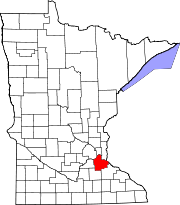- Nininger Township, Dakota County, Minnesota
-
This article is about the township. For the ghost town of the same name, see Nininger, Minnesota
Nininger Township, Minnesota — Township — Location within the state of Minnesota Coordinates: 44°44′39″N 92°55′23″W / 44.74417°N 92.92306°WCoordinates: 44°44′39″N 92°55′23″W / 44.74417°N 92.92306°W Country United States State Minnesota County Dakota Area - Total 17.2 sq mi (44.6 km2) - Land 13.3 sq mi (34.6 km2) - Water 3.9 sq mi (10.0 km2) Elevation 853 ft (260 m) Population (2000) - Total 865 - Density 64.8/sq mi (25.0/km2) Time zone Central (CST) (UTC-6) - Summer (DST) CDT (UTC-5) FIPS code 27-46330[1] GNIS feature ID 0665126[2] Nininger Township is a township in Dakota County, Minnesota, United States. The population was 865 at the 2000 census.
Contents
History
Ignatius L. Donnelly founded a utopian planned city in the northern part of the township with the hope of attracting immigrants. However, with the Panic of 1857, the plans had to be abandoned. All that currently remains of the city of Nininger are a few buildings dedicated to township management and two historical markers.
Geography
According to the United States Census Bureau, the township has a total area of 17.2 square miles (44.6 km²), of which, 13.3 square miles (34.6 km²) of it is land and 3.9 square miles (10.0 km²) of it (22.49%) is water.
Demographics
As of the census[1] of 2000, there were 865 people, 280 households, and 241 families residing in the township. The population density was 64.8 people per square mile (25.0/km²). There were 285 housing units at an average density of 21.4/sq mi (8.2/km²). The racial makeup of the township was 98.27% White, 0.12% African American, 0.12% Native American, 0.35% Asian, 0.23% from other races, and 0.92% from two or more races. Hispanic or Latino of any race were 0.81% of the population.
There were 280 households out of which 40.0% had children under the age of 18 living with them, 80.7% were married couples living together, 3.6% had a female householder with no husband present, and 13.6% were non-families. 8.9% of all households were made up of individuals and 3.6% had someone living alone who was 65 years of age or older. The average household size was 3.09 and the average family size was 3.31.
In the township the population was spread out with 27.9% under the age of 18, 9.7% from 18 to 24, 28.8% from 25 to 44, 25.4% from 45 to 64, and 8.2% who were 65 years of age or older. The median age was 37 years. For every 100 females there were 103.1 males. For every 100 females age 18 and over, there were 101.9 males.
The median income for a household in the township was $72,955, and the median income for a family was $75,477. Males had a median income of $46,146 versus $32,500 for females. The per capita income for the township was $27,337. About 1.2% of families and 2.8% of the population were below the poverty line, including 3.7% of those under age 18 and none of those age 65 or over.
References
- ^ a b "American FactFinder". United States Census Bureau. http://factfinder.census.gov. Retrieved 2008-01-31.
- ^ "US Board on Geographic Names". United States Geological Survey. 2007-10-25. http://geonames.usgs.gov. Retrieved 2008-01-31.
Municipalities and communities of Dakota County, Minnesota County seat: Hastings Cities Apple Valley | Burnsville | Coates | Eagan | Farmington | Hampton | Hastings‡ | Inver Grove Heights | Lakeville | Lilydale | Mendota | Mendota Heights | Miesville | New Trier | Northfield‡ | Randolph | Rosemount | South St. Paul | Sunfish Lake | Vermillion | West St. Paul
Townships Unincorporated
communitiesCastle Rock | Eureka Center | Waterford
Ghost town Footnotes ‡This populated place also has portions in an adjacent county or counties
Categories:- Townships in Dakota County, Minnesota
- Utopian communities
Wikimedia Foundation. 2010.



